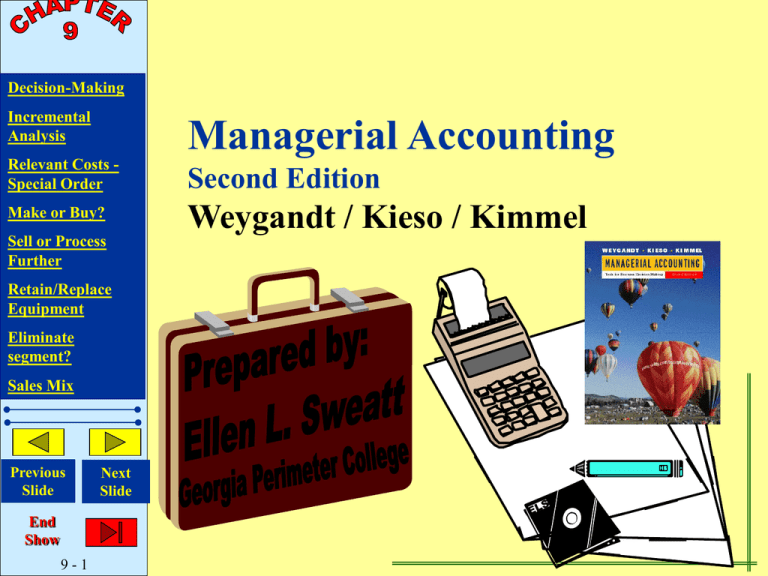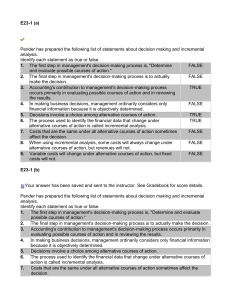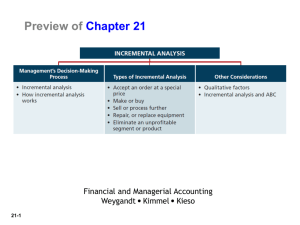
Decision-Making
Incremental
Analysis
Managerial Accounting
Relevant Costs Special Order
Second Edition
Make or Buy?
Weygandt / Kieso / Kimmel
Sell or Process
Further
Retain/Replace
Equipment
Eliminate
segment?
Sales Mix
Previous
Slide
End
Show
9-1
Next
Slide
Decision-Making
Incremental
Analysis
Relevant Costs Special Order
Make or Buy?
Sell or Process
Further
Retain/Replace
Equipment
Eliminate
segment?
Sales Mix
Previous
Slide
End
Show
9-2
Next
Slide
Incremental Analysis
Illustration 9-1
Management’s Decision-making Process
Decision-Making
Incremental
Analysis
Relevant Costs Special Order
Make or Buy?
Sell or Process
Further
Retain/Replace
Equipment
Eliminate
segment?
Sales Mix
Previous
Slide
End
Show
9-3
Next
Slide
Consider both financial and
nonfinancial information.
Nonfinancial information relates to:
• Effect of decision on employee
turnover
• The environment
• Overall image of company in
community.
Decision-Making
Incremental
Analysis
Relevant Costs Special Order
Make or Buy?
Sell or Process
Further
Retain/Replace
Equipment
Eliminate
segment?
Sales Mix
Previous
Slide
End
Show
9-4
Next
Slide
Incremental Analysis
• Sometimes both costs and
revenues vary.
• Sometimes only revenues
vary.
• Sometimes only costs vary.
Illustration 9-2
Decision-Making
Incremental
Analysis
Relevant Costs Special Order
Make or Buy?
Sell or Process
Further
Incremental Analysis
The process of identifying the
financial data that change
under alternative courses of
action.
Retain/Replace
Equipment
Eliminate
segment?
Revenues
Costs
Net income
Sales Mix
Previous
Slide
End
Show
9-5
Next
Slide
Alternative
A
$125,000
100,000
$ 25,000
Alternative
B
$110,000
80,000
$ 30,000
Net Income
Increase (Decrease)
$(15,000)
20,000
$ 5,000
Illustration 9-3
Decision-Making
Incremental
Analysis
Relevant Costs Special Order
Make or Buy?
Sell or Process
Further
Retain/Replace
Equipment
Eliminate
segment?
Sales Mix
Previous
Slide
End
Show
9-7
Next
Slide
Types of Incremental Analysis
• Accept an order at a special
price.
• Make or buy component parts
or finished products.
• Sell products or process
further.
• Retain or replace equipment.
• Eliminate an unprofitable
business segment.
Illustration 9-4
Accept An Order At A Special Price
Decision-Making
Incremental
Analysis
Relevant Costs Special Order
Make or Buy?
Sell or Process
Further
Retain/Replace
Equipment
Assume sales of the products in other
markets would not be affected by
special order.
Assume company is not operating at
full capacity.
Eliminate
segment?
Sales Mix
Previous
Slide
End
Show
9-8
Next
Slide
Revenues
Costs
Net income
Reject
Order
$ -0-0$ -0-
Accept
Order
$22,000
16,000
$ 6,000
Net Income
Increase (Decrease)
$ 22,000
(16,000)
$ 6,000
Illustration 9-5
Make or Buy
Decision-Making
Incremental
Analysis
Relevant Costs Special Order
Make or Buy?
Sell or Process
Further
Retain/Replace
Equipment
Eliminate
segment?
Sales Mix
Previous
Slide
End
Show
9-9
Next
Slide
Assume sales of the products in other
markets would not be affected by
special order.
Assume company is not operating at
full capacity.
Illustration 9-5
Make or Buy
Decision-Making
Incremental
Analysis
Relevant Costs Special Order
Make or Buy?
Sell or Process
Further
Retain/Replace
Equipment
Sales Mix
End
Show
9 - 10
Direct materials
Direct labor
Variable manufacturing overhead
Fixed manufacturing overhead
Total manufacturing costs
Total cost per unit ($225,000 25,000)
$ 50,000
75,000
40,000
60,000
$225,000
$9.00
Alternatively, Baron may purchase the
ignition switches from Ignition, Inc., at a
price of $8 per unit.
Eliminate
segment?
Previous
Slide
COST TO MAKE
Next
Slide
Question:
Should Baron make or buy the
ignition switches?
Illustration 9-6
Make or Buy
Decision-Making
Incremental
Analysis
Relevant Costs Special Order
Make or Buy?
Sell or Process
Further
Direct materials
Direct labor
Variable manufacturing costs
Fixed manufacturing costs
Purchase price
Total annual cost
Make
Buy
$ 50,000 $ - 0 75,000
-040,000
-060,000
50,000
-0200,000
$225,000 $250,000
Net Income
Increase (Decrease)
$ 50,000
75,000
40,000
10,000
(200,000)
$ (25,000)
Retain/Replace
Equipment
Eliminate
segment?
Decision:
Barton Company will incur $25,000 of additional
costs by buying the switches. Therefore, Barton
should continue to make the switches.
Sales Mix
Previous
Slide
End
Show
9 - 11
Next
Slide
Opportunity cost
Decision-Making
Incremental
Analysis
Relevant Costs Special Order
Make or Buy?
Sell or Process
Further
Retain/Replace
Equipment
Eliminate
segment?
Sales Mix
Previous
Slide
End
Show
9 - 12
Next
Slide
The potential benefit that may
be obtained from following an
alternative course of action.
Illustration 9-7
Make or Buy - Opportunity Cost
Decision-Making
Incremental
Analysis
Relevant Costs Special Order
Assume the company can use the
released capacity to generate $ 28,000
additional income.
Make or Buy?
Sell or Process
Further
Retain/Replace
Equipment
Eliminate
segment?
Total annual cost
Opportunity cost
Total cost
Make
Buy
$225,000 $250,000
28,000
-0$253,000 $250,000
Net Income
Increase (Decrease)
$(25,000)
28,000
$ 3,000
Sales Mix
Previous
Slide
End
Show
9 - 13
Next
Slide
Decision:
It is now advantageous to buy the switches. Barton will
save $3,000 worth of costs with this alternative.
Sell or Process Further?
Decision-Making
Incremental
Analysis
Relevant Costs Special Order
Make or Buy?
Sell or Process
Further
Retain/Replace
Equipment
Eliminate
segment?
Sales Mix
Previous
Slide
End
Show
9 - 14
Next
Slide
Illustration 9-8
A, Inc. makes tables. The cost to manufacture an
unfinished table is $35.
Direct materials
Direct labor
Variable manufacturing overhead
Fixed manufacturing overhead
Total manufacturing costs
$ 15
10
6
4
$35
Unfinished units sell for $50. Finished tables sell for $60
each. For a finished table direct materials and direct labor
costs will increase $2 and $4, respectively. Variable
overhead will increase by $2.40 (60% of direct labor).
There will be no increase in fixed overhead.
Question: Should A, INC. sell the unfinished
tables or process them further?
Sell or Process Further?
Sales per unit
Cost per unit
Direct materials
Direct labor
Variable manufacturing overhead
Fixed manufacturing overhead
Total
Net income per unit
Illustration 9-9
Sell
$50.00
Process
Further
$60.00
Net Income
Increase (Decrease)
$10.00
15.00
10.00
6.00
4.00
$35.00
17.00
14.00
8.40
4.00
$43.40
(2.00)
(4.00)
(2.40)
-0$(8.40)
$15.00
$16.60
$ 1.60
Process further as long as the
incremental revenue from such
processing exceeds the incremental
processing costs.
Joint costs
Decision-Making
Incremental
Analysis
Relevant Costs Special Order
Make or Buy?
Sell or Process
Further
Retain/Replace
Equipment
Eliminate
segment?
Sales Mix
Previous
Slide
End
Show
9 - 16
Next
Slide
For joint products, all costs
incurred prior to the point at
which two products are
separately identifiable.
Illustration 9-10
Sell/Process Further-Multiple Products
Decision-Making
Incremental
Analysis
Relevant Costs Special Order
Make or Buy?
Sell or Process
Further
Retain/Replace
Equipment
Use Incremental Analysis to Decide.
Eliminate
segment?
Sales Mix
Previous
Slide
End
Show
9 - 17
Next
Slide
Sunk cost
Decision-Making
Incremental
Analysis
Relevant Costs Special Order
Make or Buy?
Sell or Process
Further
Retain/Replace
Equipment
Eliminate
segment?
Sales Mix
Previous
Slide
End
Show
9 - 18
Next
Slide
The book value of the old machine is a
sunk cost which is a cost that cannot
be changed by any present or future
decision. Sunk costs are not relevant
in incremental analysis.
Retain or Replace Equipment
Decision-Making
Incremental
Analysis
Relevant Costs Special Order
Make or Buy?
Sell or Process
Further
Retain/Replace
Equipment
Eliminate
segment?
Jeffcoat Company has a factory machine
with a book value of $40,000 and a
remaining useful life of four years. A new
machine is available for $120,000 and is
expected to have zero salvage value at the
end of its 4-year useful life. If the new
machine is acquired, variable
manufacturing costs are expected to
decrease from $160,000 to $125,000
annually and the old unit will be scrapped.
Sales Mix
Previous
Slide
End
Show
9 - 19
Next
Slide
Question:
Should Jeffcoat Company retain
or replace the machine?
Illustration 9-14
Retain or Replace Equipment
Variable manufacturing costs
New machine cost
Total
Retain
$640,000a
$640,000
Replace
$500,000b
120,000
$620,000
Net Income
Increase (Decrease)
$140,000
(120,000)
$ 20,000
a(4
years x $160,000)
b(4 years x $125,000)
Decision:
It would be to the company’s advantage to replace the equipment. The
lower variable manufacturing costs due to replacement more than offset the
cost of the new equipment.
Eliminate An Unprofitable Segment
Decision-Making
Incremental
Analysis
Relevant Costs Special Order
Make or Buy?
Often fixed costs allocated to the
unprofitable segment must be
absorbed by the other segments.
Sell or Process
Further
Retain/Replace
Equipment
Eliminate
segment?
Sales Mix
Previous
Slide
End
Show
9 - 21
Next
Slide
It is possible for net income to
decrease when an unprofitable
segment is eliminated.
Illustration 9-15
Eliminate An Unprofitable Segment
Decision-Making
Incremental
Analysis
Relevant Costs Special Order
Make or Buy?
Martina Company manufactures tennis racquets in
three models: Pro, Master, and Champ. Pro and
Master are profitable lines, whereas Champ operates
at a loss. Condensed income statement data are:
Sell or Process
Further
Retain/Replace
Equipment
Eliminate
segment?
Sales
Variable expenses
Contribution margin
Fixed expenses
Net income
Sales Mix
Previous
Slide
End
Show
9 - 22
Next
Slide
Pro
$800,000
520,000
280,000
80,000
$200,000
Master
$300,000
210,000
90,000
50,000
$ 40,000
Champ
$100,000
90,000
10,000
30,000
$(20,000)
Total
$1,200,000
820,000
380,000
160,000
$ 220,000
Question:
Should the Champ segment be eliminated?
Illustrations 9-15&9-16
Eliminate An Unprofitable Segment
Decision-Making
Incremental
Analysis
Relevant Costs Special Order
Make or Buy?
Sales
Variable expenses
Contribution margin
Fixed expenses
Net income
Pro
$800,000
520,000
280,000
80,000
$200,000
Master
$300,000
210,000
90,000
50,000
$ 40,000
Champ
$100,000
90,000
10,000
30,000
$(20,000)
Total
$1,200,000
820,000
380,000
160,000
$ 220,000
Sell or Process
Further
Retain/Replace
Equipment
Eliminate
segment?
Sales Mix
Previous
Slide
End
Show
9 - 23
Next
Slide
ELIMINATE CHAMP?
Sales
Variable expenses
Contribution margin
Fixed expenses
Net income
Pro
$800,000
520,000
280,000
100,000
$200,000
Master
Total
$300,000 $1,100,000
210,000
730,000
90,000
370,000
60,000
160,000
$ 40,000 $ 210,000
Total net income decreases $10,000
($220,000 – $210,000) if the Champ line is
discontinued.
Decision:
Illustrations 9-15&9-16
Eliminate An Unprofitable Segment
Decision-Making
Incremental
Analysis
Relevant Costs Special Order
Make or Buy?
Sales
Variable expenses
Contribution margin
Fixed expenses
Net income
Pro
$800,000
520,000
280,000
80,000
$200,000
Master
$300,000
210,000
90,000
50,000
$ 40,000
Champ
$100,000
90,000
10,000
30,000
$(20,000)
Total
$1,200,000
820,000
380,000
160,000
$ 220,000
Sell or Process
Further
Retain/Replace
Equipment
Eliminate
segment?
Sales Mix
Previous
Slide
End
Show
9 - 24
Next
Slide
ELIMINATE CHAMP?
Sales
Variable expenses
Contribution margin
Fixed expenses
Net income
Pro
$800,000
520,000
280,000
100,000
$200,000
Master
Total
$300,000 $1,100,000
210,000
730,000
90,000
370,000
60,000
160,000
$ 40,000 $ 210,000
Total net income decreases $10,000
($220,000 – $210,000) if the Champ line is
discontinued.
Decision:
Illustrations 9-17
Eliminate An Unprofitable Segment
Decision-Making
Incremental
Analysis
Total net income decreases $10,000
($220,000 – $210,000) if the Champ line is
discontinued.
Decision:
Relevant Costs Special Order
Make or Buy?
Sell or Process
Further
OR
Retain/Replace
Equipment
Eliminate
segment?
Sales Mix
Previous
Slide
End
Show
9 - 25
Next
Slide
Sales
Variable expenses
Contribution margin
Fixed expenses
Net income
Continue
$100,000
90,000
10,000
30,000
$(20,000)
Eliminate
$ -0-0-030,000
$ 30,000)
Net Income
Increase (Decrease
$(100,000)
90,000
(10,000)
-0$ (10,000)
Joint products
Decision-Making
Incremental
Analysis
Relevant Costs Special Order
Make or Buy?
Sell or Process
Further
Retain/Replace
Equipment
Eliminate
segment?
Sales Mix
Previous
Slide
End
Show
9 - 26
Next
Slide
Multiple end-products
produced from a single raw
material and a common
process.
Sales Mix
Decision-Making
Incremental
Analysis
Relevant Costs Special Order
Make or Buy?
Sell or Process
Further
Retain/Replace
Equipment
Eliminate
segment?
Sales Mix
Previous
Slide
End
Show
9 - 27
Next
Slide
The relative combination in
which a company’s products
are sold.
Illustration 9-18
Sales Mix
Decision-Making
Incremental
Analysis
Relevant Costs Special Order
Make or Buy?
Sell or Process
Further
Retain/Replace
Equipment
Eliminate
segment?
Sales Mix
Previous
Slide
End
Show
9 - 28
Next
Slide
Unit Data
Selling price
Variable costs
Contribution margin
Sales mix
VCRs
$500
300
$200
TVs
$800
400
$400
3
1
Illustration 9-21
Limited Resources
Decision-Making
Incremental
Analysis
Relevant Costs Special Order
Make or Buy?
Collins Co. manufactures deluxe and standard pen
and pencil sets. The limited resource is machine
capacity, which is 3,600 hours per month.
Relevant data consists of:
Sell or Process
Further
Retain/Replace
Equipment
Eliminate
segment?
Contribution margin per unit
Machine hours required per unit
Deluxe
$8
.4
Standard
$6
.2
Sales Mix
Previous
Slide
End
Show
9 - 29
Next
Slide
Question:
Should Collins Co. shift its sales mix toward
deluxe or standard sets?
Illustration 9-22
Limited Resources
Decision-Making
Incremental
Analysis
Relevant Costs Special Order
Make or Buy?
Sell or Process
Further
Retain/Replace
Equipment
Eliminate
segment?
Sales Mix
Previous
Slide
End
Show
9 - 30
Next
Slide
Contribution margin per unit (a)
Machine hours required per unit (b)
Contribution margin per unit of
limited resource (a b)
Deluxe
$8
.4
$20
Decision: Since the standard set has the
higher contribution margin per unit of
limited resource, sales mix should shift
towards that product.
Standard
$6
.2
$30
Decision-Making
COPYRIGHT
Incremental
Analysis
Relevant Costs Special Order
Copyright © 2002, John Wiley & Sons, Inc. All rights reserved.
Reproduction or translation of this work beyond that permitted in
Make or Buy?
Section
Sell or
Process 117 of the 1976 United States Copyright Act without the
Further
express written permission of the copyright owner is unlawful.
Retain/Replace
Request for further information should be addressed to the
Equipment
Permissions Department, John Wiley & Sons, Inc. The purchaser
Eliminate
segment?
may make back-up copies for his/her own use only and not for
Salesdistribution
Mix
or resale. The Publisher assumes no responsibility
for errors, omissions, or damages, caused by the use of these
programs or from the use of the information contained herein.
Previous
Slide
End
Show
9 - 31
Next
Slide







